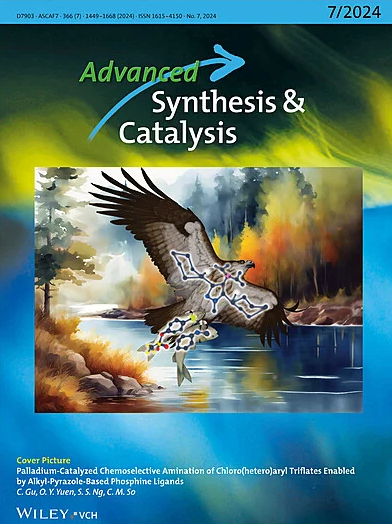Light Mediated Sulfonylation/C–H Activation/Annulation of Benzimidazoles Derivatives Catalyzed by Diarylmethylium Tetrafluoroborate Salts: An Experimental and Computational Study
IF 4
2区 化学
Q2 CHEMISTRY, APPLIED
引用次数: 0
Abstract
In this article, diarylmethylium tetrafluoroborates are exploited as catalysts in a visible light promoted domino sulfonylation/C–H activation/annulation of四氟硼酸二芳基甲基盐催化苯并咪唑衍生物的光介导磺化/碳氢活化/环化:实验和计算研究
本文以四氟硼酸二甲基甲基为催化剂,通过可见光催化N -炔基苯并咪唑的多米诺磺化/ C-H活化/环化反应制备了多环磺酰基苯并咪唑。环状苯并咪唑以其生物学和药用特性而闻名,是药物研究和药物发现中的重要结构。在温和和无金属的条件下,获得了20多种多环磺酰苯并咪唑,包括氮卓类,收率很高。一个基于实验和计算研究的机制建议,建立了阳离子催化剂和亚硫酸盐之间形成的光活性离子对在产生关键磺酰自由基中的作用。后者增加了三键,从而促进了一个多米诺骨牌过程,其中酸添加剂在氢转移中起着基本作用。此外,酸催化的质子耦合电子转移关闭了催化循环,使二芳基正碳盐再生,从而产生所需的产品。
本文章由计算机程序翻译,如有差异,请以英文原文为准。
求助全文
约1分钟内获得全文
求助全文
来源期刊

Advanced Synthesis & Catalysis
化学-应用化学
CiteScore
9.40
自引率
7.40%
发文量
447
审稿时长
1.8 months
期刊介绍:
Advanced Synthesis & Catalysis (ASC) is the leading primary journal in organic, organometallic, and applied chemistry.
The high impact of ASC can be attributed to the unique focus of the journal, which publishes exciting new results from academic and industrial labs on efficient, practical, and environmentally friendly organic synthesis. While homogeneous, heterogeneous, organic, and enzyme catalysis are key technologies to achieve green synthesis, significant contributions to the same goal by synthesis design, reaction techniques, flow chemistry, and continuous processing, multiphase catalysis, green solvents, catalyst immobilization, and recycling, separation science, and process development are also featured in ASC. The Aims and Scope can be found in the Notice to Authors or on the first page of the table of contents in every issue.
 求助内容:
求助内容: 应助结果提醒方式:
应助结果提醒方式:


